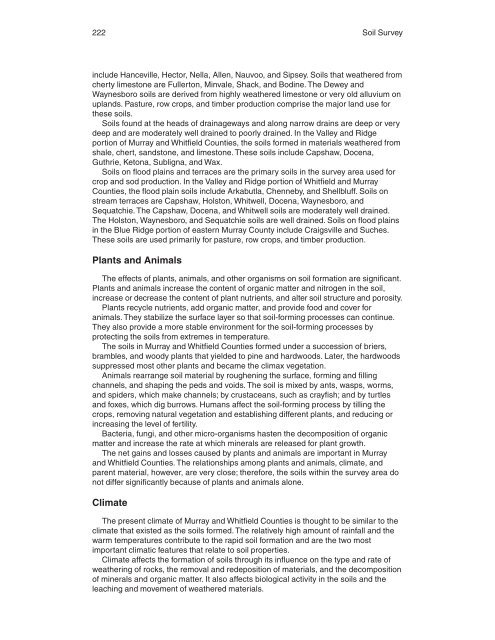Soil Survey of Murray and Whitfield Counties, Georgia
Soil Survey of Murray and Whitfield Counties, Georgia
Soil Survey of Murray and Whitfield Counties, Georgia
You also want an ePaper? Increase the reach of your titles
YUMPU automatically turns print PDFs into web optimized ePapers that Google loves.
222 <strong>Soil</strong> <strong>Survey</strong><br />
include Hanceville, Hector, Nella, Allen, Nauvoo, <strong>and</strong> Sipsey. <strong>Soil</strong>s that weathered from<br />
cherty limestone are Fullerton, Minvale, Shack, <strong>and</strong> Bodine. The Dewey <strong>and</strong><br />
Waynesboro soils are derived from highly weathered limestone or very old alluvium on<br />
upl<strong>and</strong>s. Pasture, row crops, <strong>and</strong> timber production comprise the major l<strong>and</strong> use for<br />
these soils.<br />
<strong>Soil</strong>s found at the heads <strong>of</strong> drainageways <strong>and</strong> along narrow drains are deep or very<br />
deep <strong>and</strong> are moderately well drained to poorly drained. In the Valley <strong>and</strong> Ridge<br />
portion <strong>of</strong> <strong>Murray</strong> <strong>and</strong> <strong>Whitfield</strong> <strong>Counties</strong>, the soils formed in materials weathered from<br />
shale, chert, s<strong>and</strong>stone, <strong>and</strong> limestone. These soils include Capshaw, Docena,<br />
Guthrie, Ketona, Subligna, <strong>and</strong> Wax.<br />
<strong>Soil</strong>s on flood plains <strong>and</strong> terraces are the primary soils in the survey area used for<br />
crop <strong>and</strong> sod production. In the Valley <strong>and</strong> Ridge portion <strong>of</strong> <strong>Whitfield</strong> <strong>and</strong> <strong>Murray</strong><br />
<strong>Counties</strong>, the flood plain soils include Arkabutla, Chenneby, <strong>and</strong> Shellbluff. <strong>Soil</strong>s on<br />
stream terraces are Capshaw, Holston, Whitwell, Docena, Waynesboro, <strong>and</strong><br />
Sequatchie. The Capshaw, Docena, <strong>and</strong> Whitwell soils are moderately well drained.<br />
The Holston, Waynesboro, <strong>and</strong> Sequatchie soils are well drained. <strong>Soil</strong>s on flood plains<br />
in the Blue Ridge portion <strong>of</strong> eastern <strong>Murray</strong> County include Craigsville <strong>and</strong> Suches.<br />
These soils are used primarily for pasture, row crops, <strong>and</strong> timber production.<br />
Plants <strong>and</strong> Animals<br />
The effects <strong>of</strong> plants, animals, <strong>and</strong> other organisms on soil formation are significant.<br />
Plants <strong>and</strong> animals increase the content <strong>of</strong> organic matter <strong>and</strong> nitrogen in the soil,<br />
increase or decrease the content <strong>of</strong> plant nutrients, <strong>and</strong> alter soil structure <strong>and</strong> porosity.<br />
Plants recycle nutrients, add organic matter, <strong>and</strong> provide food <strong>and</strong> cover for<br />
animals. They stabilize the surface layer so that soil-forming processes can continue.<br />
They also provide a more stable environment for the soil-forming processes by<br />
protecting the soils from extremes in temperature.<br />
The soils in <strong>Murray</strong> <strong>and</strong> <strong>Whitfield</strong> <strong>Counties</strong> formed under a succession <strong>of</strong> briers,<br />
brambles, <strong>and</strong> woody plants that yielded to pine <strong>and</strong> hardwoods. Later, the hardwoods<br />
suppressed most other plants <strong>and</strong> became the climax vegetation.<br />
Animals rearrange soil material by roughening the surface, forming <strong>and</strong> filling<br />
channels, <strong>and</strong> shaping the peds <strong>and</strong> voids. The soil is mixed by ants, wasps, worms,<br />
<strong>and</strong> spiders, which make channels; by crustaceans, such as crayfish; <strong>and</strong> by turtles<br />
<strong>and</strong> foxes, which dig burrows. Humans affect the soil-forming process by tilling the<br />
crops, removing natural vegetation <strong>and</strong> establishing different plants, <strong>and</strong> reducing or<br />
increasing the level <strong>of</strong> fertility.<br />
Bacteria, fungi, <strong>and</strong> other micro-organisms hasten the decomposition <strong>of</strong> organic<br />
matter <strong>and</strong> increase the rate at which minerals are released for plant growth.<br />
The net gains <strong>and</strong> losses caused by plants <strong>and</strong> animals are important in <strong>Murray</strong><br />
<strong>and</strong> <strong>Whitfield</strong> <strong>Counties</strong>. The relationships among plants <strong>and</strong> animals, climate, <strong>and</strong><br />
parent material, however, are very close; therefore, the soils within the survey area do<br />
not differ significantly because <strong>of</strong> plants <strong>and</strong> animals alone.<br />
Climate<br />
The present climate <strong>of</strong> <strong>Murray</strong> <strong>and</strong> <strong>Whitfield</strong> <strong>Counties</strong> is thought to be similar to the<br />
climate that existed as the soils formed. The relatively high amount <strong>of</strong> rainfall <strong>and</strong> the<br />
warm temperatures contribute to the rapid soil formation <strong>and</strong> are the two most<br />
important climatic features that relate to soil properties.<br />
Climate affects the formation <strong>of</strong> soils through its influence on the type <strong>and</strong> rate <strong>of</strong><br />
weathering <strong>of</strong> rocks, the removal <strong>and</strong> redeposition <strong>of</strong> materials, <strong>and</strong> the decomposition<br />
<strong>of</strong> minerals <strong>and</strong> organic matter. It also affects biological activity in the soils <strong>and</strong> the<br />
leaching <strong>and</strong> movement <strong>of</strong> weathered materials.
















